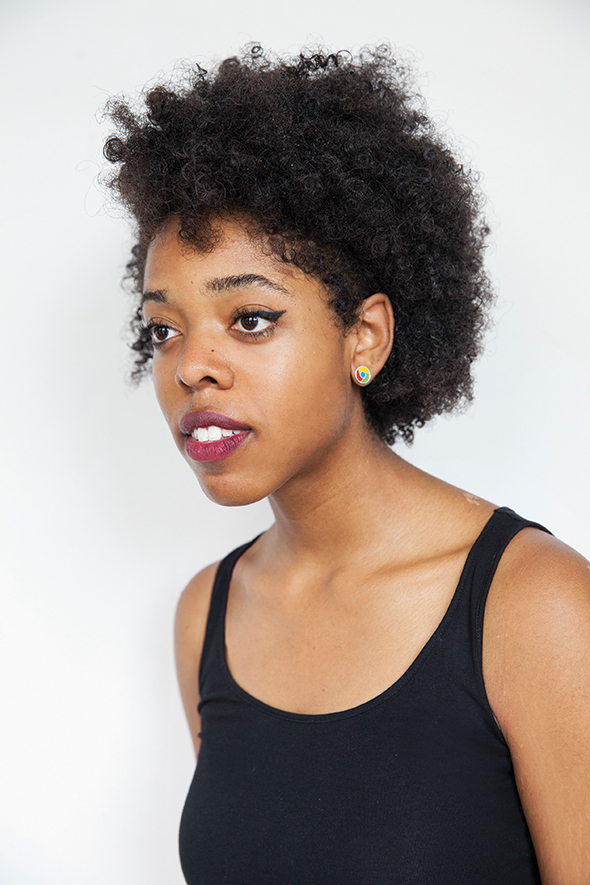The Influencers

Madison Maxey is a tinker for the 21st century. As a self-described creative technologist, Maxey focuses on e-textiles and wearables with the potential to change the role apparel and fabrics can play in our lives.
She grew up in San Diego where her mother worked as a flight attendant and her father was an aerospace engineer at Northrup Grumman, which seeded her interest in technology. The California native began her career in fashion at age 16, taking internships at Tommy Hilfiger and Nylon Magazine before she was accepted to Parsons School of Design.
After less than a year at the esteemed college, Maxey became the first fashion designer to receive a Thiel Fellowship – a grant that enables students to quit or defer their enrollment in university in the pursuit of building their own companies and products in the real world. As a fellow in 2013, Maxey started her own startup called The Crated. The company prototyped a myriad of products, including a temperature-controlled light jacket, wearable EKG monitor and a light-emitting diode dress, made with help from Zac Posen and Google and debuted at New York Fashion Week.
Instead of returning to college, she’s learned skills like coding by practicing them on her own projects. Maxey has gone on to receive residencies at Autodesk and The School of Visual Arts and Undercurrent, and serves on the board of the Urban Assembly Maker Academy – a school that’s focused on fabrications and design thinking. Last year, Maxey relaunched The Crated as Loomia in Brooklyn, New York. The company is pioneering flexible smart fabrics that conduct electricity in patterns, turning fabrics into circuits.
Maxey believes these e-textiles can impact not just apparel, but also furniture, industrial wear, and wristbands by bringing electricity to the products to track our biomarkers and potentially affect them for the better.
Since you dropped out of Parsons for the Thiel Fellowship, how did you learn the skills you needed to work on your projects?
I learn skills by working on projects. I think experiential learning is a great way to grow.
How did The Crated pivot to Loomia?
The name The Crated sounded like the opposite of what we want to be. It sounded boxed in and restrictive. We think Loomia sounds much more future-minded and forward-thinking. Good things are always evolving, so we decided it was time to change the name.
What are you most excited about developing at Loomia? And why do you feel it’s important?
I’m excited about Loomia because we’re building foundational technology that will help the smart soft goods industry grow. It excites me to think that we might be able to make a technical contribution to an emerging industry.
Where do you think e-textiles will or should go in the next five years?
I hope that e-textiles will be industrialized and affordable in the next five years. Where there is great supply chain, there are great products.
Where are you in the process of simplifying the garment industry today?
Our entire supply chain for Loomia is domestic, so we’re getting closer to the goal of making it smart to manufacture soft goods and apparel in the states. As for pattern-making techniques, I’m working on it as a side project. Life is long and I hope to complete the software someday.
What was the nature of your advising to the White House?
One of Michelle Obama’s assistants called me to discuss a workshop they were planning on e-textiles at the White House. I was glad to be able to orient her around the space.
You’ve worked at Autodesk, as well. What did you develop and what skills or spirit did you pick up while there?
I interned on an Autodesk 3D printing, working on writing code that would generate files for their SLA DLP printer. I returned for an artist residency last year and built a small plotter that extrudes conductive liquid onto textiles. I also worked in the wet lab on conductive ink formulas. I’m actually returning to Autodesk for another project in a few weeks. I’m deeply inspired by the level of curiosity there.
With climate change bringing such unusual weather patterns, could e-textiles that regulate body temp be a new green approach to heating, potentially replacing home air conditioners and furnaces?
I don’t know if body temp regulation can replace central air or heating, but I do think it can give us ways to stay comfortable in a changing climate. Especially for the elderly or disabled, external body temp regulation can be particularly helpful.
Text by Valerie Demicheva

